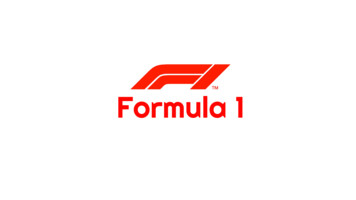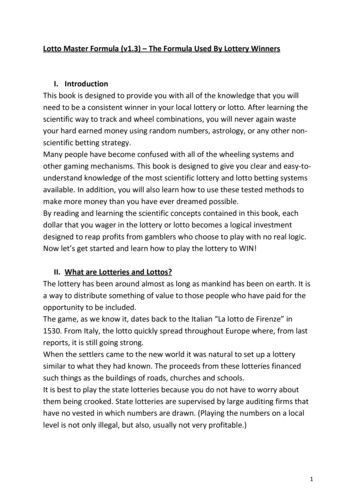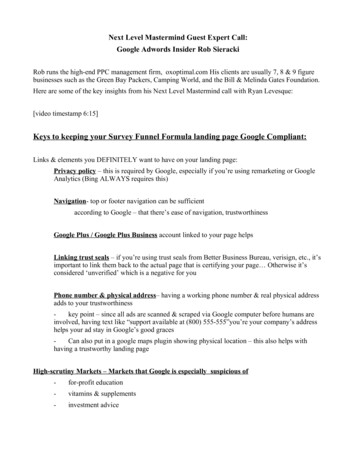
Transcription
Formula 1
What is Formula 1 ?
What is Formula 1 ?Highest class of single seater auto racing
What is Formula 1 ?Highest class of single seater auto racingWay better than IndyCar/NASCAR** Personal opinion. Might not align with your views. Let’s not go to war over this. #peace #nonviolence
Totally crap history overview.
History 1946: Formula One was started by the Fédération Internationale del'Automobile's (FIA). “Formula” refers to the set of rules which everyone has to follow.
History 1946: Formula One was started by the Fédération Internationale del'Automobile's (FIA). “Formula” refers to the set of rules which everyone has to follow. 1950: The world championship was introduced. First race at Silverstone in the UK.
History 1946: Formula One was started by the Fédération Internationale del'Automobile's (FIA). “Formula” refers to the set of rules which everyone has to follow. 1950: The world championship was introduced. First race at Silverstone in the UK. Car manufacturers like Ferrari, Alfa Romeo, Maserati, Cooperparticipated.
History 1946: Formula One was started by the Fédération Internationale del'Automobile's (FIA). “Formula” refers to the set of rules which everyone has to follow. 1950: The world championship was introduced. First race at Silverstone in the UK. Car manufacturers like Ferrari, Alfa Romeo, Maserati, Cooperparticipated. Only 6 races were counted towards the championship.
History 1946: Formula One was started by the Fédération Internationale del'Automobile's (FIA). “Formula” refers to the set of rules which everyone has to follow. 1950: The world championship was introduced. First race at Silverstone in the UK. Car manufacturers like Ferrari, Alfa Romeo, Maserati, Cooperparticipated. Only 6 races were counted towards the championship. Alpha Romeo destroyed its competition.
HistoryAlpha Romeo 158
HistoryAlpha Romeo 158Ferrari SF71H
History 1953: Argentina hosted the first race outside Europe.
History 1953: Argentina hosted the first race outside Europe. 1958: The first race in Africa (Morocco).
History 1953: Argentina hosted the first race outside Europe. 1958: The first race in Africa (Morocco). 1985: First race in Australia.
History 1953: Argentina hosted the first race outside Europe. 1958: The first race in Africa (Morocco). 1985: First race in Australia. 1994: Ayrton Senna and Roland Ratzenberger died in the San Marino race. Thisprompted F1 to improve car safety standards.
History
Let’s first address somemisconceptions.
Wait. You are Indian. Why aren’t youtalking about cricket?
Wait. You are Indian. Why aren’t youtalking about cricket?Psych! This is a presentation on cricket.
Introduction to Cricket Cricket is a bat and ball game played between 2 teams.
Introduction to Cricket Cricket is a bat and ball game played between 2 teams.
Sounds simple. Car. Race. Fastest carwins.
Sounds simple. Car. Race. Fastest carwins.Not just about the car.
Sounds simple. Car. Race. Fastest carwins.Not just about the car.Drivers. Strategy. Teamwork. Efforts of a team of 100 people.
Sounds simple. Car. Race. Fastest carwins.Not just about the car.Drivers. Strategy. Teamwork. Efforts of a team of 100 people.The fastest car doesn’t always win.
But F1 drivers just need to drive a car.They aren’t athletes.
But F1 drivers just need to drive a car.They aren’t athletes.They drive in upto 50 C temperatures. Sweat upto 3L a race.
But F1 drivers just need to drive a car.They aren’t athletes.They drive in upto 50 C temperatures. Sweat upto 3L a race.Handle G-Force of upto 5g. More than a space shuttle launch.
But F1 drivers just need to drive a car.They aren’t athletes.They drive in upto 50 C temperatures. Sweat upto 3L a race.Handle G-Force of upto 5g. More than a space shuttle launch.Heart rate is approximately 170 bpm for 2 hours.
F1 is boring. Cars just go around incircles.
F1 is boring. Cars just go around incircles.The tracks are not circular! Varying speeds, bumps and corners.
BelgiumMonacoCanada
What do you need to know in order towatch F1 today.
Overview10 teams
Overview20 drivers
Overview20 drivers
Overview21 races. 5 continents.Each race is called a Grand Prix.
OverviewEach race finish gives you points.
OverviewEach race finish gives you points.Driver with the most points at the end wins the World Championship.
OverviewEach race finish gives you points.Driver with the most points at the end wins the World Championship.
OverviewTeam with the most points wins the Constructors Championship.
Let’s look at the Canadian Grand Prixto understand what happens duringeach race.
Race Weeknd
Race WeekendEvery race has events spread across 3 days.
Race WeekendEvery race has events spread across 3 days. Friday: 2 practice sessions of 90 min each.
Race WeekendEvery race has events spread across 3 days. Friday: 2 practice sessions of 90 min each. Saturday: 1 practice session of 60 min.
Race WeekendEvery race has events spread across 3 days. Friday: 2 practice sessions of 90 min each. Saturday: 1 practice session of 60 min.A driver must take part in at least 1 practice session to be eligible forthe race.
Race Weekend Saturday: 3 Qualifying sessions to determine the startingpositions on track. Q1: 18 minutes. All 20 cars compete. Slowest 5 cars areeliminated.
Race Weekend Saturday: 3 Qualifying sessions to determine the startingpositions on track. Q1: 18 minutes. All 20 cars compete. Slowest 5 cars areeliminated. Q2: 15 minutes. 15 cars compete. Slowest 5 cars areeliminated.
Race Weekend Saturday: 3 Qualifying sessions to determine the startingpositions on track. Q1: 18 minutes. All 20 cars compete. Slowest 5 cars areeliminated. Q2: 15 minutes. 15 cars compete. Slowest 5 cars areeliminated. Q3: 12 minutes. Decides the final ordering for the top 10 cars.
Race Weekend
Importance of Qualifying
Importance of Qualifying
Race Weekend Sunday: Race day! Cars line up on the grid.
Race Weekend Sunday: Race day! Cars line up on the grid. 1 formation lap to warm the tyres.
Race Weekend Sunday: Race day! Cars line up on the grid. 1 formation lap to warm the tyres. It’s lights out and away we go!
Race Weekend
What happens if there is an accident?
First let’s look at F1’s obsession withflags
Flags 10 different types.
Flags 10 different types.
Flags Chequered Flag: Hooray! You have crossed the finish line
FlagsChequered Flag: Hooray! You have crossed the finish line Yellow Flag: Indicates danger. 1 yellow flag: warns driver to slow down 2 yellow flags: drivers must slow down No overtaking!
FlagsChequered Flag: Hooray! You have crossed the finish line Yellow Flag: Indicates danger. Green Flag: All good to race again.
FlagsChequered Flag: Hooray! You have crossed the finish line Yellow Flag: Indicates danger. Green Flag: All good to race again. Blue Flag: Tells driver he isn’t good enough.
FlagsChequered Flag: Hooray! You have crossed the finish line Yellow Flag: Indicates danger. Green Flag: All good to race again. Blue Flag: Tells driver he isn’t good enough. Warns the driver thathe is about to be lapped and to let the faster car overtake.
Flags Chequered Flag: Hooray! You have crossed the finish lineYellow Flag: Indicates danger.Green Flag: All good to race again.Blue Flag: Tells driver he isn’t good enough. Warns the driver thathe is about to be lapped and to let the faster car overtake.Black Flag: Tells driver that they have been excluded from therace.
Flags Chequered Flag: Hooray! You have crossed the finish lineYellow Flag: Indicates danger.Green Flag: All good to race again.Blue Flag: Tells driver he isn’t good enough. Warns the driver thathe is about to be lapped and to let the faster car overtake.Black Flag: Tells driver that they have been excluded from therace.Red Flag: Indicates that the session has been stopped. Maybe dueto accident or poor race conditions.
Safety Cars In case of double yellow flags, there are two possible ways ofdealing with it.
Safety Cars In case of double yellow flags, there are two possible ways ofdealing with it. Virtual Safety Car: Called if things are not that serious. Driversare required to reduce their speeds to match a safety car(virtual).
Safety Cars In case of double yellow flags, there are two possible ways ofdealing with it. Virtual Safety Car: Called if things are not that serious. Driversare required to reduce their speeds to match a safety car(virtual). Safety Car: When things are serious. All cars must line upbehind the safety car.
Safety Cars In case of double yellow flags, there are two possible ways ofdealing with it. Virtual Safety Car: Called if things are not that serious. Driversare required to reduce their speeds to match a safety car(virtual). Safety Car: When things are serious. All cars must line upbehind the safety car.No overtaking in any of the two cases!
Safety Cars
Number of LapsEach race has several laps depending upon the track length.The number of laps will be equal to the least number which exceeds a distance of305 km (260 km for Monaco). However, should two hours elapse before thescheduled race distance is completed, the leader will be shown the chequered flagwhen he crosses the line.
Number of LapsEach race has several laps depending upon the track length.The number of laps will be equal to the least number which exceeds a distance of305 km (260 km for Monaco). However, should two hours elapse before thescheduled race distance is completed, the leader will be shown the chequered flagwhen he crosses the line.Canadian Grand Prix track is 4.361 km long. Therefore, the race has 70 laps.
Pit StopsDuring each race, a car will go into the pit lane one or more times tochange tyres/ do any repairs on the car.
Annual F1 Pop QuizHow long should it take to change all 4 tyreson a car?a. 10 secb. 10 minc. 1 hourd. Can’t do it. I am a CS grad student
Pit Stops
Pit Stops
An exhausting diversion
An exhausting diversionTyres
Tyres Really important!
TyresReally important! All tyres are supplied by Pirelli.
TyresReally important! All tyres are supplied by Pirelli. Two categories of tyres: Dry weather compounds Wet weather compounds
Annual F1 Pop Quiz
Annual F1 Pop QuizHow many types of tyres were there duringthe 2011 season?a. 6b. 7c. 8d. 9
Annual F1 Pop QuizHow many types of tyres were there duringthe 2011 season?a. 6b. 7c. 8d. 9
Annual F1 Pop QuizHow many types of tyres were there duringthe 2014 season?a. 6b. 7c. 8d. 9
Annual F1 Pop QuizHow many types of tyres were there duringthe 2014 season?a. 6b. 7c. 8d. 9
Annual F1 Pop QuizHow many types of tyres were there duringthe 2016 season?a. 6b. 7c. 8d. 9
Annual F1 Pop QuizHow many types of tyres were there duringthe 2018 season?a. 6b. 7c. 8d. 9
Annual F1 Pop QuizHow many types of tyres were there duringthe 2018 season?a. 6b. 7c. 8d. 9
Tyres
Tyres
Tyres
Simplified anatomy of a F1 car
Simplified anatomy of a F1 carWHAT’S IN THE CAR?
Inside a F1 car 6 major components.
Inside a F1 car 6 major components. Each team can develop/obtain the components as long as theysatisfy the guidelines.
Inside a F1 car 6 major components. Each team can develop/obtain the components as long as theysatisfy the guidelines. Teams only have a limited number of components for a particularseason. If they exceed that number, they get a penalty.
Inside a F1 car
Inside a F1 car
Steering wheel
Steering wheel
The art of overtaking.
Car AerodynamicsDownforce
Car AerodynamicsDrag
Slipstream Imagine Car A is trying to overtake Car B on a straight.
Dirty Air Imagine Car A is trying to overtake Car B on a corner.
Drag Reduction System (DRS) If Car A is within 1 second of Car B when entering a particularregion of the track, it can activate DRS to get a temporary speedboost.
Drag Reduction System (DRS)
Now that we know all the importantthings, let’s look at some strategies.
Overtaking StrategiesDRS Slipstream OP Late Braking
Overtaking Strategies
Tyre selection Depending on where you start on the grid, tyre selection dictateshow many pit stops a car will make.
Tyre selection Depending on where you start on the grid, tyre selection dictateshow many pit stops a car will make. If you are starting in front, you might want to go on the softercompound tyres.
Tyre selection Depending on where you start on the grid, tyre selection dictateshow many pit stops a car will make. If you are starting in front, you might want to go for the softercompound tyres. If you are starting at the end, you might want to go for theharder compound tyres.
Undercut
UndercutPits earlier
Undercut
UndercutPits later
UndercutSuccessfulovertake
Free Pit Stop A pit stop usually costs time.
Free Pit StopA pit stop usually costs time. But depending on the situation, you can get a free pit stop if thereis a safety car.
A bit of teamwork Each team has two drivers.
A bit of teamworkEach team has two drivers. The team can strategically make One driver pass the other Pit one car hoping to achieve an undercut
Car Setup Drivers can manually set their cars up depending on what theysee during practice. They can go for more downforce if the track has a lot of turns
Car Setup Drivers can manually set their cars up depending on what theysee during practice. They can go for more downforce if the track has a lot of turns They can change front and rear wing angles for responsiveturning.
Car Setup Drivers ca
1946: Formula One was started by the Fédération Internationale de l'Automobile's (FIA). “Formula” refers to the set of rules which everyone has to follow. 1950: The world championship was introduced. First race at Silverstone in the UK. Car manufacturers like











